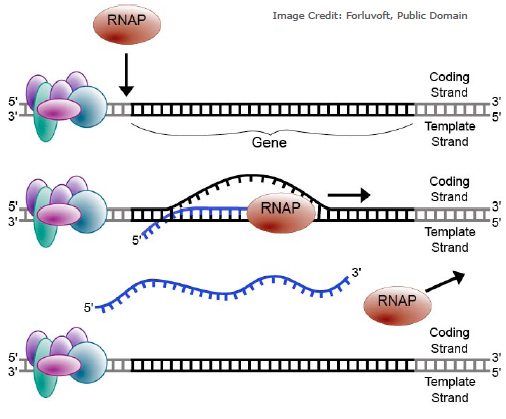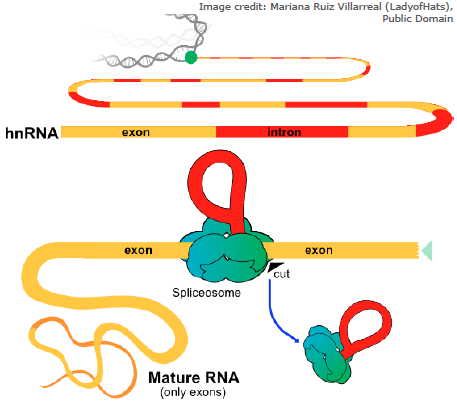Reading: Protein Synthesis
Big Picture
Key Terms
Central Dogma of Molecular Biology: Doctrine that genetic instructions in DNA are copied by RNA, which carries them to a ribosome where they are used to synthesize a protein.
Protein Synthesis: Process in which cells make proteins that includes transcription of DNA and translation of mRNA.
Genetic Code: Universal code of three-base codons that encodes the genetic instructions for the amino acid sequence of proteins.
Codon: Group of three nitrogen bases in nucleic acids that makes up a code “word” of the genetic code and stands for an amino acid, start, or stop.
Transcription: Process in which genetic instructions in DNA are copied to form a complementary strand of mRNA.
RNA Polymerase: An enzyme that helps produce RNA during transcription.
Promoter Site: Region of a gene where a RNA polymerase binds to initiate transcription of the gene.
Introns: Non-coding regions of mRNA that are re-moved by splicing.
Extrons: Coding regions.
Translation: Process in which genetic instructions in mRNA are “read” to synthesize a protein.
Types of RNA:
Messenger RNA (mRNA): Type of RNA that copies genetic instructions from DNA in the nucleus and carries them to ribosomes in the cytoplasm.
Ribosomal RNA (rRNA): Type of RNA that helps form ribosomes and assemble proteins.
Transfer RNA (tRNA): Type of RNA that brings amino acids to ribosomes where they are joined together to form proteins
Protein Synthesis
The Genetic Code
During protein synthesis, the protein is built up one amino acid at a time. DNA contains the information that determines which amino acid comes next.
DNA is made up of four different nitrogen bases: adenosine (A), thymine (T), cytosine (C), and guanine (G).
These bases make up the genetic code. All living things have the same genetic code. Groups of three of these bases form a codon that stands for an amino acid or codes for a start or stop signal.
Role of RNA
DNA always stays in the nucleus, yet the actual process of protein synthesis occurs in the ribosomes of the rough endoplasmic reticulum. Instructions coding for a specific protein from the DNA are transferred to the ribosomes in the form of RNA, a small molecule that can leave the nucleus. The codons in RNA are complementary to the codons in DNA, so the thymine (T) in DNA is replaced with uracil (U) in RNA.
There are three main types of RNA:
• messenger RNA (mRNA): copies the genetic instructions from DNA in the nucleus and carries them to ribosomes in the cytoplasm
• ribosomal RNA (rRNA): helps form ribosomes
• transfer RNA (tRNA): brings amino acids to ribosomes
While DNA can make protein, protein cannot make DNA.
Reading the Genetic
To figure out the amino acids that make up protein, search for the start codon (AUG).
• There is only one start codon - protein synthesis must always start from AUG.
From AUG, group three letters at a time. Use a table to find what amino acid each codon codes for.
• Continue until you reach a stop codon (UAG, UGA, and UAA).
• The start and stop codons do not code for any amino acids - they only signal for protein synthesis to begin or to stop.

You can see in the table that the genetic code is redundant. There are
64 possible codons, yet proteins contain only 20 amino acids.
Transcription
Transcription, the processing of making mRNA complementary to the DNA tem-plate, is broken down into 3 steps:
1. Initiation: An enzyme called RNA polymerase binds to the end of a coding region called the promoter. The DNA unwinds its double helix structure.
2. Elongation: After unwinding, RNA polymerase adds the complemen-tary nucleotides to the new, budding mRNA strand.
3. Termination: The completed pre-mRNA strand detaches from the DNA strand.

Processing mRNA
Before the pre-mRNA (also known as the hnRNA) strand can exit the nucleus, it must be modified.
These modifications include splicing, which removes introns from the pre-mRNA with spliceosomes.
The finished, mature mRNA then proceeds to translation.

Translation
After leaving the nucleus, the strand of mRNA moves to a ribosome.
There, translation involves two different RNA molecules: mRNA (from
transcription) and tRNA.
mRNA can be thought of as a guide or organizer, while the tRNA are the workers with the materials. tRNA carries anticodon complementary to the codon on mRNA. Whenever the anticodon on tRNA binds to the codon on mRNA, tRNA gives up its amino acid. The ribosome continues to build the protein until it reaches a stop codon.

Common Misconceptions
• After transcription and before RNA processing, mRNA is called the pre-mRNA. This might be mislead you to think that RNA processing turns this pre-mRNA into mRNA. However, even before RNA processing, pre-mRNA is still a messenger RNA.
• RNA polymerase creates one RNA strand from only one of the two DNA strands at a time.
